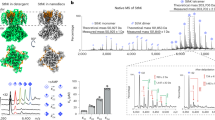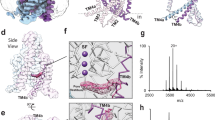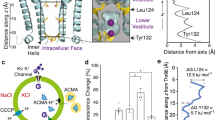Abstract
TRAAK is an ion channel from the two-pore domain potassium (K2P) channel family with roles in maintaining the resting membrane potential and fast action potential conduction. Regulated by a wide range of physical and chemical stimuli, the affinity and selectivity of K2P4.1 toward lipids remains poorly understood. Here we show the two isoforms of K2P4.1 have distinct binding preferences for lipids dependent on acyl chain length and position on the glycerol backbone. The channel can also discriminate the fatty acid linkage at the SN1 position. Of the 33 lipids interrogated using native mass spectrometry, phosphatidic acid had the lowest equilibrium dissociation constants for both isoforms of K2P4.1. Liposome potassium flux assays with K2P4.1 reconstituted in defined lipid environments show that those containing phosphatidic acid activate the channel in a dose-dependent fashion. Our results begin to define the molecular requirements for the specific binding of lipids to K2P4.1.

This is a preview of subscription content, access via your institution
Access options
Access Nature and 54 other Nature Portfolio journals
Get Nature+, our best-value online-access subscription
$29.99 / 30 days
cancel any time
Subscribe to this journal
Receive 12 print issues and online access
$259.00 per year
only $21.58 per issue
Buy this article
- Purchase on Springer Link
- Instant access to full article PDF
Prices may be subject to local taxes which are calculated during checkout




Similar content being viewed by others
Data availability
The native MS data are available on Zenodo (https://doi.org/10.5281/zenodo.3993214). Source data are provided with this paper.
Code availability
Python code is available at GitHub (https://github.com/LaganowskyLab/Laganowsky_Lab_Code.git).
References
Heurteaux, C. et al. TREK-1, a K+ channel involved in neuroprotection and general anesthesia. EMBO J. 23, 2684–2695 (2004).
Alloui, A. et al. TREK-1, a K+ channel involved in polymodal pain perception. EMBO J. 25, 2368–2376 (2006).
Blondeau, N. et al. Polyunsaturated fatty acids are cerebral vasodilators via the TREK-1 potassium channel. Circ. Res. 101, 176–184 (2007).
Noel, J. et al. The mechano-activated K+ channels TRAAK and TREK-1 control both warm and cold perception. EMBO J. 28, 1308–1318 (2009).
Enyedi, P. & Czirjak, G. Molecular background of leak K+ currents: two-pore domain potassium channels. Physiol. Rev. 90, 559–605 (2010).
Feliciangeli, S., Chatelain, F. C., Bichet, D. & Lesage, F. The family of K2P channels: salient structural and functional properties. J. Physiol. 593, 2587–2603 (2015).
Es-Salah-Lamoureux, Z., Steele, D. F. & Fedida, D. Research into the therapeutic roles of two-pore-domain potassium channels. Trends Pharmacol. Sci. 31, 587–595 (2010).
Noel, J., Sandoz, G. & Lesage, F. Molecular regulations governing TREK and TRAAK channel functions. Channels 5, 402–409 (2011).
Cabanos, C., Wang, M., Han, X. L. & Hansen, S. B. A soluble fluorescent binding assay reveals PIP2 antagonism of TREK-1 channels. Cell Rep. 20, 1287–1294 (2017).
Vivier, D., Bennis, K., Lesage, F. & Ducki, S. Perspectives on the two-pore domain potassium channel TREK-1 (TWIK-Related K(+) Channel 1). A novel therapeutic target? J. Med. Chem. 59, 5149–5157 (2016).
Chemin, J. et al. Up- and down-regulation of the mechano-gated K(2P) channel TREK-1 by PIP (2) and other membrane phospholipids. Pflug. Arch. 455, 97–103 (2007).
Comoglio, Y. et al. Phospholipase D2 specifically regulates TREK potassium channels via direct interaction and local production of phosphatidic acid. Proc. Natl Acad. Sci. USA 111, 13547–13552 (2014).
Lopes, C. M. et al. PIP2 hydrolysis underlies agonist-induced inhibition and regulates voltage gating of two-pore domain K+ channels. J. Physiol. 564, 117–129 (2005).
Chung, H. W. et al. A molecular target for an alcohol chain-length cutoff. J. Mol. Biol. 431, 196–209 (2019).
Fink, M. et al. A neuronal two P domain K+ channel stimulated by arachidonic acid and polyunsaturated fatty acids. EMBO J. 17, 3297–3308 (1998).
Chemin, J. et al. Lysophosphatidic acid-operated K+ channels. J. Biol. Chem. 280, 4415–4421 (2005).
Juarez-Contreras, R., Rosenbaum, T. & Morales-Lazaro, S. L. Lysophosphatidic acid and ion channels as molecular mediators of pain. Front Mol. Neurosci. 11, 462 (2018).
Maingret, F., Patel, A. J., Lesage, F., Lazdunski, M. & Honore, E. Lysophospholipids open the two-pore domain mechano-gated K(+) channels TREK-1 and TRAAK. J. Biol. Chem. 275, 10128–10133 (2000).
Brohawn, S. G., del Marmol, J. & MacKinnon, R. Crystal structure of the human K2P TRAAK, a lipid- and mechano-sensitive K+ ion channel. Science 335, 436–441 (2012).
Brohawn, S. G., Su, Z. & MacKinnon, R. Mechanosensitivity is mediated directly by the lipid membrane in TRAAK and TREK1 K+ channels. Proc. Natl Acad. Sci. USA 111, 3614–3619 (2014).
Dong, Y. Y. et al. K2P channel gating mechanisms revealed by structures of TREK-2 and a complex with Prozac. Science 347, 1256–1259 (2015).
Lolicato, M. et al. K2P2.1 (TREK-1)-activator complexes reveal a cryptic selectivity filter binding site. Nature 547, 364–368 (2017).
Lolicato, M., Riegelhaupt, P. M., Arrigoni, C., Clark, K. A. & Minor, D. L. Jr. Transmembrane helix straightening and buckling underlies activation of mechanosensitive and thermosensitive K(2P) channels. Neuron 84, 1198–1212 (2014).
Brohawn, S. G., Campbell, E. B. & MacKinnon, R. Physical mechanism for gating and mechanosensitivity of the human TRAAK K+ channel. Nature 516, 126–130 (2014).
McClenaghan, C. et al. Polymodal activation of the TREK-2 K2P channel produces structurally distinct open states. J. Gen. Physiol. 147, 497–505 (2016).
Bolla, J. R., Agasid, M. T., Mehmood, S. & Robinson, C. V. Membrane protein–lipid interactions probed using mass spectrometry. Annu. Rev. Biochem. 88, 85–111 (2019).
Laganowsky, A., Reading, E., Hopper, J. T. & Robinson, C. V. Mass spectrometry of intact membrane protein complexes. Nat. Protoc. 8, 639–651 (2013).
Laganowsky, A. et al. Membrane proteins bind lipids selectively to modulate their structure and function. Nature 510, 172–175 (2014).
Hilton, G. R. & Benesch, J. L. Two decades of studying non-covalent biomolecular assemblies by means of electrospray ionization mass spectrometry. J. R. Soc. Interface 9, 801–816 (2012).
Gupta, K. et al. The role of interfacial lipids in stabilizing membrane protein oligomers. Nature 541, 421–424 (2017).
Liu, Y. et al. Selective binding of a toxin and phosphatidylinositides to a mammalian potassium channel. Nat. Commun. 10, 1352 (2019).
Cong, X. et al. Determining membrane protein-lipid binding thermodynamics using native mass spectrometry. J. Am. Chem. Soc. 138, 4346–4349 (2016).
Cong, X., Liu, Y., Liu, W., Liang, X. & Laganowsky, A. Allosteric modulation of protein-protein interactions by individual lipid binding events. Nat. Commun. 8, 2203 (2017).
Yen, H. Y. et al. PtdIns(4,5)P2 stabilizes active states of GPCRs and enhances selectivity of G-protein coupling. Nature 559, 423–427 (2018).
Patrick, J. W. et al. Allostery revealed within lipid binding events to membrane proteins. Proc. Natl Acad. Sci. USA 115, 2976–2981 (2018).
Marcoux, J. et al. Mass spectrometry reveals synergistic effects of nucleotides, lipids, and drugs binding to a multidrug resistance efflux pump. Proc. Natl Acad. Sci. USA 110, 9704–9709 (2013).
Gault, J. et al. High-resolution mass spectrometry of small molecules bound to membrane proteins. Nat. Methods 13, 333–336 (2016).
Brohawn, S. G., Campbell, E. B. & MacKinnon, R. Domain-swapped chain connectivity and gated membrane access in a Fab-mediated crystal of the human TRAAK K+ channel. Proc. Natl Acad. Sci. USA 110, 2129–2134 (2013).
Poltash, M. L, McCabe, J. W., Patrick, J. W., Laganowsky, A. & Russell, D. H. Development and evaluation of a reverse-entry ion source orbitrap mass spectrometer. J. Am. Soc. Mass Spec. 30, 192–198 (2018).
Laemmli, U. K. Cleavage of structural proteins during the assembly of the head of bacteriophage T4. Nature 227, 680–685 (1970).
Lyu, J. et al. Discovery of potent charge-reducing molecules for native ion mobility mass spectrometry studies. Anal. Chem. 92, 11242–11249 (2020).
Ben-Nissan, G. & Sharon, M. The application of ion-mobility mass spectrometry for structure/function investigation of protein complexes. Curr. Opin. Chem. Biol. 42, 25–33 (2018).
Poltash, M. L. et al. Fourier transform-ion mobility-orbitrap mass spectrometer: a next-generation instrument for native mass spectrometry. Anal. Chem. 90, 10472–10478 (2018).
Harayama, T. & Riezman, H. Understanding the diversity of membrane lipid composition. Nat. Rev. Mol. Cell Biol. 19, 281–296 (2018).
Brohawn, S. G. et al. The mechanosensitive ion channel TRAAK is localized to the mammalian node of Ranvier. eLife 8, https://doi.org/10.7554/eLife.50403 (2019).
Farooqui, A. A., Farooqui, T. & Horrocks, L. A. (eds) In Metabolism and Functions of Bioactive Ether Lipids in the Brain 85–106 (Springer, 2008).
Hargreaves, K. & Clandinin, M. T. Dietary lipids in relation to postnatal development of the brain. Ups. J. Med Sci. Suppl. 48, 79–95 (1990).
Qiao, P., Liu, Y., Zhang, T., Benavides, A. & Laganowsky, A. Insight into the selectivity of Kir3.2 toward phosphatidylinositides. Biochemistry 59, https://doi.org/10.1021/acs.biochem.0c00163 (2020).
Robinson, C. V., Rohacs, T. & Hansen, S. B. Tools for understanding nanoscale lipid regulation of ion channels. Trends Biochem. Sci. 44, 795–806 (2019).
Levitz, J. et al. Heterodimerization within the TREK channel subfamily produces a diverse family of highly regulated potassium channels. Proc. Natl Acad. Sci. USA 113, 4194–4199 (2016).
Shaner, N. C. et al. Improved monomeric red, orange and yellow fluorescent proteins derived from Discosoma sp. red fluorescent protein. Nat. Biotechnol. 22, 1567–1572 (2004).
Weis, R. High-throughput screening and selection of Pichia pastoris strains. Methods Mol. Biol. 1923, 169–185 (2019).
Chen, P. S., Toribara, T. Y. & Warner, H. Microdetermination of phosphorus. Anal. Chem. 28, 1756–1758 (1956).
Allison, T. M. et al. Quantifying the stabilizing effects of protein-ligand interactions in the gas phase. Nat. Commun. 6, 8551 (2015); https://doi.org/10.1038/ncomms9551
Marklund, E. G., Degiacomi, M. T., Robinson, C. V., Baldwin, A. J. & Benesch, J. L. Collision cross sections for structural proteomics. Structure 23, 791–799 (2015).
Virtanen, P. et al. SciPy 1.0: fundamental algorithms for scientific computing in Python. Nat. Methods 17, 261–272 (2020).
Alexander, W. M., Ficarro, S. B., Adelmant, G. & Marto, J. A. multiplierz v2.0: a Python-based ecosystem for shared access and analysis of native mass spectrometry data. Proteomics 17, 1700091 (2017).
Marty, M. T. et al. Bayesian deconvolution of mass and ion mobility spectra: from binary interactions to polydisperse ensembles. Anal. Chem. 87, 4370–4376 (2015).
Hunter, J. D. Matplotlib: a 2D graphics environment. Comput. Sci. Eng. 9, 90–95 (2007).
Su, Z. W., Brown, E. C., Wang, W. W. & MacKinnon, R. Novel cell-free high-throughput screening method for pharmacological tools targeting K+ channels. PNAS 113, 5748–5753 (2016).
Acknowledgements
This work was supported by the National Institute of General Medical Sciences of the National Institutes of Health (NIH) awarded to A.L. (grant no. DP2GM123486) and development of custom instrumentation supported by NIH (grant no. P41GM128577-01, D.R.).
Author information
Authors and Affiliations
Contributions
S.S., Y.Z. and A.L. designed the research. S.S., Y.Z. and C.P. expressed and purified the protein. S.S. and M.B. carried out molecular biology experiments. S.S. and Y.Z. performed the native MS experiments and Y.Z. conducted functional assays. S.S., Y.Z. and A.L. analyzed the data. S.S., Y.Z. and A.L. wrote the manuscript with input from the other authors.
Corresponding author
Ethics declarations
Competing interests
The authors declare no competing interests.
Additional information
Publisher’s note Springer Nature remains neutral with regard to jurisdictional claims in published maps and institutional affiliations.
Extended data
Extended Data Fig. 1 Optimization of expression and purification of human K2P4.1 for native ion mobility mass spectrometry studies.
a, Shown are representative mass spectra of the K2P4.1b fusion protein acquired on a Synapt G1 HDMS instrument. Denoted in the inset is the detergent abbreviation: dodecyl maltoside (DDM); decyl maltoside (DM); lauryldimethylamine-N-oxide (LDAO); pentaethylene glycol monodecyl ether (C10E5); and octaethylene glycol monododecyl ether (C12E8). The polyethylene glycol detergents, C10E5 and C12E8, yielded well resolved mass spectra compared to the other detergents screened. b, Membrane proteins were expressed with affinity tags fused to both termini. Shown is the native mass spectrum for K2P4.1b with tags removed by TEV protease in C10E5 acquired on an Orbitrap. c, Native ion mobility mass spectra of the K2P4.1a fusion protein solubilized in (left) 2x CMC C10E5 and with the addition of (right) 50 mM spermidine acquired on Synapt G1. In the absence of charge-reducing molecule, the arrival time distributions are broad for high charge states indicating collisional activation (or partial unfolding) of the protein complex. d, Collision induced unfolding (CIU) plot of arrival time distribution for the 9+ charge state of K2P4.1a with tags removed in C10E5 and spermidine acquired under different collision voltages (10 V step size) on a Synapt G1 instrument. The arrival time distribution for the 9+ and other charge states of K2P4.1a remain constant showing that charge reduction aids retention of native-like structure, even at the highest collision voltage (240 V). e, Ion mobility mass spectrum for K2P4.1a in C10E5 and spermidine recorded on an Orbitrap UHMR equipped with a REIS and 1.5 m drift tube operating in the FT-mode. f, Collision cross section profiles for different charge states of K2P4.1a. The centroid CCS for the 10+, 9+, and 8+ are 4559, 4528, 4547 Å2, respectively. The calculated CCS for PDB 4WFE is 4656 Å2.
Extended Data Fig. 2 Native mass spectra for weakly (or no) binding lipids to K2P4.1a.
Shown are native mass spectra for K2P4.1a in the presence of 20 µM of lipid. Lipid abbreviations are provided in Supplementary Table 1.
Extended Data Fig. 3 Determination of equilibrium dissociation constants (KD) for lipids binding K2P4.1a.
Shown are representative native mass for K2P4.1a in the presence of 20 µM of lipid. Plots of mole fraction (right panel) for apo K2P4.1a and bound to different number of lipids determined from a titration series (dots with error bars to represent the three measurements) and resulting fit from a sequential lipid-binding model (solid lines). Lipid abbreviations are provided in Supplementary Table 1.
Extended Data Fig. 4 Determination of KD for lysolipids and PIPs binding K2P4.1a.
Shown as described in Extended Data Fig. 3. * and ** denote lipid concentrations of 15 μM and 10 μM, respectively.
Extended Data Fig. 5 Determination of KD for lipids binding K2P4.1b.
Shown as described for Extended Data Fig. 3. * and ** denote lipid concentrations of 15 μM and 10 μM, respectively.
Extended Data Fig. 6 Determination of KD for lysolipids, PIPs lipids binding K2P4.1b.
Shown as described for Extended Data Fig. 3. * and ** denote lipid concentrations of 15 μM and 10 μM, respectively.
Extended Data Fig. 7 Liposome potassium flux assays of K2P4.1a reconstituted in POPC.
a-d, Flux assay traces for K2P4.1a reconstituted in POPC and POPC doped with POPG or POPA. Empty liposomes of the same lipid composition are shown in gray. The mole fraction (%) of doped lipid is shown in the inset. e, Photograph of a silver stained SDS-PAGE of different proteoliposome mixtures used in the liposome potassium flux assays. Bands corresponding to monomer and dimer K2P4.1a are denoted by a single and double asterisk, respectively. The Precision Plus Protein Dual Color Standard (Bio-Rad) protein ladder was loaded in the first lane and molecular weight in kDa is shown to the left. The white scale bar (lower right corner) represents 1 cm. f, Densitometry analysis of K2P4.1a monomeric bands. No statistical differences were found between the different samples. Shown are the mean and standard deviation (n = 3) for three independent experiments (white dots).
Supplementary information
Supplementary Information
Supplementary Tables 1–3
Source data
Source Data Fig. 2
Kd values for each replicate
Source Data Fig. 3
Kd values for each replicate
Source Data Fig. 4
Liposome flux for each experiment
Source Data Extended Data Fig. 7
Unprocessed stained gel, densitometry measurements
Rights and permissions
About this article
Cite this article
Schrecke, S., Zhu, Y., McCabe, J.W. et al. Selective regulation of human TRAAK channels by biologically active phospholipids. Nat Chem Biol 17, 89–95 (2021). https://doi.org/10.1038/s41589-020-00659-5
Received:
Accepted:
Published:
Issue Date:
DOI: https://doi.org/10.1038/s41589-020-00659-5
This article is cited by
-
Polyamine detergents tailored for native mass spectrometry studies of membrane proteins
Nature Communications (2023)
-
Membrane phospholipids control gating of the mechanosensitive potassium leak channel TREK1
Nature Communications (2023)
-
Anionic lipids unlock the gates of select ion channels in the pacemaker family
Nature Structural & Molecular Biology (2022)



